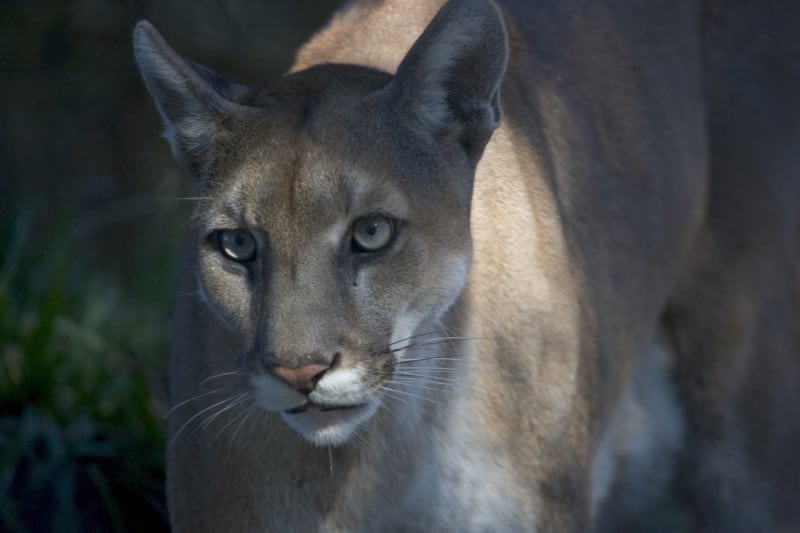
Florida Panther Facts
- This majestic product of Nature and evolution most commonly goes by the highly informative common name of the Florida Panther. It also has several other general names, though. These include such similar terms as Florida cougar, Florida Puma, and Coast Rican puma.
- Among scientific professionals, however, it’s probably much better known by its formal moniker. That’s the rather different term of Puma concolor cougar. Regardless of the title one chooses to use when referring to it, it represents a severely threatened subspecies of cougar.
- The marvel of Nature received that technical name due to the efforts of the American zoologist, Outram Bangs. This researcher accomplished the first known acknowledgement of it as a separate and distinct species. That scientifically noteworthy action occurred in the year 1899.
- The magnificent mammal also represents the only known subspecies of cougar in the portion of the country it lives in. To the knowledge of wildlife experts, though, it only occupies 5% of its former range. Current estimates place its total population at just over 200 individuals.
- Given this sad clearly lamentable situation, the IUCN now lists the animal as Critically Endangered. That status is reflected on the organization’s Red List of Threatened Species. Incredibly, before protections existed, its numbers once dwindled to only 20 specimens.
- Because of its scant numbers and restricted range, it understandably continues to face numerous threats to its continued existence. Habitat loss due to human expansion obviously qualifies. Like most species on earth, though, it also now faces the perils of climate change.
Related Articles
Florida Panther Physical Description
The magnificent Florida Panther immediately impresses anyone fortunate enough to view one, especially in the wild. Much like its close relatives, it does so due to a combination of factors. One’s its sheer size. Though certainly not quite as large as some wild felines, it’s nonetheless respectable.
Also following a pattern common to its many kin around the world, the animal shows a moderate degree of the physiological trait of sexual dimorphism. In its case, this natural trait manifests itself purely in terms of sheer size. In overall appearance, however, the genders appear the same.
Regarding those aforementioned physical dimensions, though, males most often attain larger growth than their female counterparts. These reach weights equaling up to a very respectable 159 lb (72 kg). The males also attain a known head-to-tail length that ranges from 5.9 – 7.2 ft (1.8 – 2.2 m).
Females of the species, meanwhile, generally reach moderately shorter lengths. This gendere also develops a somewhat more slender shape. This further reduces their mass in comparison with males. As a result, these usually reach a weight that ranges from between 64 – 100 lb (29 – 45.5 kg).
The sexes of the mesmerizing Florida Panther remain virtually indistinguishable based on patterns of color alone, however. Interestingly, at birth, both present a spotted pattern, and striking blue eyes. As these mature, though, the eyes change to a yellowish shade, while the spots disappear entirely.
Among mature adult specimens of the animal, the fur of the upper body takes on a very deep tan hue. The underbelly of the gorgeous mammal, though, usually manifests a creamy white shade in color. In contrast, extremely distinctive black markings manifest on the tips of the tail and ears.
- Kingdom: Animalia
- Phylum: Chordata
- Class: Mammalia
- Order: Carnivora
- Family: Felidae
- Genus: Puma
- Species: P. concolor
- Subspecies: P. c. couguar
Florida Panther Distribution, Habitat, and Ecology
Sadly, the stunning Florida Panther evolved as indigenous to an extremely limited portion of the world. The exact location of that zone of habitation certainly won’t surprise anyone, though. That’s due to the simple fact that its very name provides a clear indication of where that range lies.
As indicated, it inhabits the area that now comprises the sate of Florida, in the United States, in North America. Yet even within this already severely restricted territory, it only inhabits a portion of its former range therein. That reduced region consists of the southeastern portion of the state.
Evidence does clearly indicate, however, that the wonder of the animal kingdom once possessed a respectably greater territorial range. It’s known to have once been present in at least 6 other states. Those consisted of Texas, Louisiana, Alabama, Mississippi, Georgia, and parts of South Carolina.
Like many wildcats, it displays decidedly strong and clear preferences pertaining to its choice of habitat. It’s also highly adapted to these. Today, its range consists almost exclusively of the swamps, forests, and grasslands of southern Florida, particularly the Everglades and Big Cypress Swamp.
Even in these areas it lives almost exclusively in only very specific ecosystems. These consist of regions of the rapidly vanishing tropical hardwood hammocks, pinelands, or mixed freshwater swamp forests. Luckily, much of the animal’s little remaining range now lies within protected areas.
Again following a pattern common to wild felines, each individual Florida Panther generally migrates through its territory. This movement mainly occurs during the day. Most specimens prefer to spend their days in wetlands, then move to grassland in the evening. It’s also mainly nocturnal.
Given its feline ancestry, it naturally evolved as purely carnivorous in nature. Its prey typically consists of a broad variety of smaller animals. It will, however, occasionally attack larger prey. These typically include such species as deer or wild boar. Alligators form its only known natural predator.
Species Sharing Its Range
Check out our other articles on 4 Outstanding Orchids of Australia, Scalloped Hammerhead, McMurdo Dry Valleys, Little Auk, Philippine Cobra, Eastern Tiger Swallowtail, Australian Sea Lion
